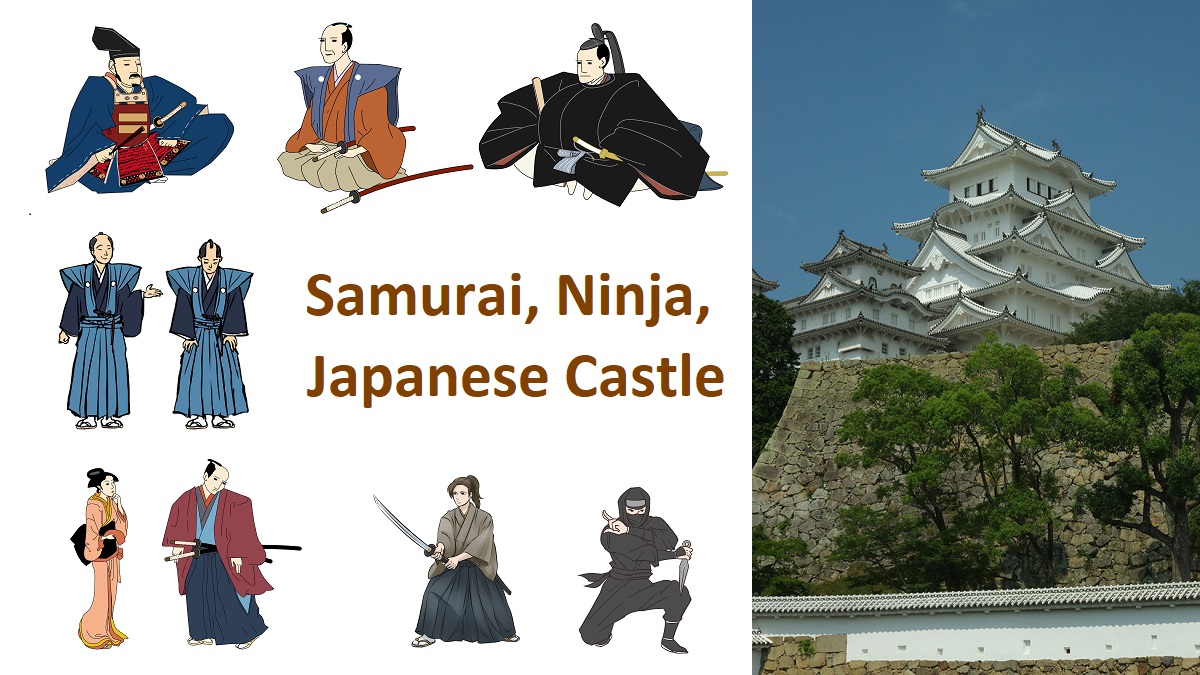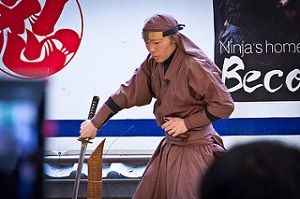Samurai, Ninja, Japanese Castle
About Samurai
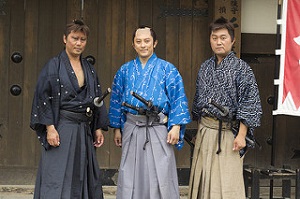
Style of Samurai, Photo by Japanexperterna.se
From the ancient times, Japan has been a country with a national polity based on the Emperor’s family.
The ancestors of Emperor’s family are described as the gods in Japanese myth.
In the ancient times, the Emperor was a god and a policymaker.
As Japan formed a nation, the Emperor and the dignitaries needed the guards to protect from revolt and leaking of confidential information.
They are the origin of Samurai.
(They are also called Bushi.)
As the centuries roll by, they began taking power.
In the 13th century, though the Emperor was the top of Japan, Samurai began to steer the nation.
At that time, Japan was not yet a unified nation, and there were many local countries where the Samurais governed the people on their own power.
Some local countries had strong power and they had an ambition to conquer territory.
During the 15th to 16th centuries, whole of Japan was a combat area by such Samurais.
In the late 16th century, Oda Nobunaga, one of the strongest feudal warlords, was going to unify Japan.
But he was killed by his enemy in 1582, then Toyotomi Hideyoshi, the confidant of Nobunaga, became the incomer.
He achieved a unified state in 1590, at last.
But, he died in 1598, and long-awaited Tokugawa Ieyasu appeared and had all the power.
These three warlords are the historic heroes who are most popular with Japanese people.
Tokugawa Ieyasu moved the capital functions from Kyoto where the Emperor lives to Edo which is now called Tokyo.
This was the real starting point of the era that Samurais govern the nation.
Tokugawa’s era lasted until 1868 for over 260 years.
This period is called Edo Period.
During this period, Edo government had an isolationist policy.
In such environment, Japanese people created various culture such as Haiku, tea ceremony, Kabuki, Ukiyoe (Japanese woodblock prints), sushi, etc.
In this period, samurai became policymaker serving Shogun, the most influential person of the nation appointed by the Emperor.
Samurai worked as government employees, local official, police, judge, etc.
Now most Japanese people have such image for Samurai.
In this period, four categories of the people were defined as a feudal class system.
The highest class was Samurai.
And farmer, craftsman and merchant were lower than Samurai.
A non-Samurai couldn’t become a Samurai, and the child of Samurai was raised to be a Samurai.
Samurai wears the topknot (“Chonmage” in Japanese).
Of course, most Japanese men wore Chonmage and women wore Nihongami during Edo Period.
In modern Japan, only Sumo wrestles wear Chonmage and Geisha girls wear Nihongami.
Samurai wears a sword.
Basically, he uses it only for his own defense or for “Harakiri” as I write later.
Only Samurai was allowed to own a sword, and it was a sign of Samurai.
Because Samurais were leaders of the public, they were essential to study morality and philosophy and to practice his swordsmanship.
Manners were always required, and they had lived with formal mind every day.
Such situation developed the spiritual basis of Japanese people.
Allegiance, patience, selfless devotion, benevolence and righteousness, etc.
I think these moral behaviors of Samurai have been passed to modern Japanese people as culture.
Of course, some samurais broke a rule, committed a criminal act, turned to corruption, or raised a rebellion.
The heaviest punishment for such crime was “Harakiri” (or “Seppuku”).
This was a punishment for only Samurai.
This was one of death punishments, and the condemned Samurai killed himself by his own sword in accordance with manner.
Such feudal Samurai era ended in 1868.
Because, Tokugawa government was overthrown by progressive Samurais, then new government of parliamentarism from Western Europe was established.
Chonmage was cut and it was forbidden to belt on a sword.
And class systems were abolished and Samurai ceased to exist.
About Ninja
In medieval war era, the warriors working behind the scenes appeared in addition to the warrior battling enemies directly in the field.
It was Ninja.
The groups of Ninja lived in the mountain area about 50 km far away from Kyoto which was the capital of Japan.
The main groups are Koka and Iga.
Koka is in current Shiga Prefecture and Iga is in Mie Prefecture.
The distance between the two areas is only within 20 km.
("O" in "Koka" is pronounced long as "Kôka".
And, it has also been called as "Kôga".)
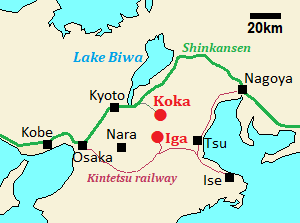
Position of Koka & Iga
Koka Ninja was a commando serving the local warlord, but they had been brought to ruin after the establishment of Edo government.
Iga Ninja worked on a contract with the client warlord.
Therefore, they were used as spy or agent during Edo Period.
Ninja isn’t Samurai.
They usually disguised themselves as common people in the town of target.
Only when they performed their duty, they wore combat uniform with muted color and had some special and portable weapons.
They acted in secret and moved even in deep forest and under water.
They had been specially trained in their village so that they could do such action.
In drama and manga, the showy combat scenes by Ninja are depicted.
But main duty of Ninja was collecting information of the enemy, so it is said that such scenes are fictions.
Ninja also ceased to exist at the end of Edo Period.
Many of them turned their work into policeman or martialist of new government.
In Koka city, there is "Koka Ninja Village".
In Iga city, there is "Iga-ryu Ninja Museum".
Japanese castle
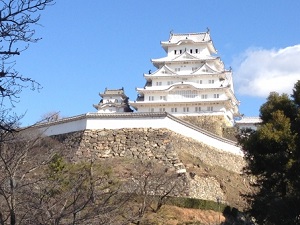
Himeji Castle
Japanese castles were originally military forts.
They were constructed in the 14th to 16th centuries.
The local lord lived in the castle and governed his country.
And he elaborated a strategy to strengthen his country and win a battle.
In addition, many samurais serving him lived around the castle, and they guarded the lord and the castle as the fort.
After civil war period, Japan was unified as a nation and feudal Edo (current Tokyo) Government was founded in 1603.
Since that, the castles were changed to the governing base of each local area.
The lord of the area lived in the castle, and became the local governor under the central government in Edo.
Around major castle, merchants and workmen had gathered and the castle town was formed.
Most of current main cities in Japan had developed as castle town.
The symbolic buiding of Japanese castle is "Castle Tower", but it was mainly built as the symbol of the castle, literally.
It is 2 to 5 stories high and is constructed on a foundation.
The main function is a lookout tower.
The area of a castle is surrounded with moats, and high stone walls are constructed to prevent the invasion of enemies or Ninja.
The lord of castle lived in the palace built near the castle tower.
And some buildings with government function are set up in the area.
Many Samurais serving the lord became the government officials.
Samurai towns surrounded the castle, and many government offices were set up.
Of course, the Samurais lived in the town.
This was the center of the local capital, and the town of general citizens was formed around the castle.
Many of local cities has been formed so.
After the feudal period, modern government demolished most castles in the 1870s.
And many preserved castles were destroyed by air raids in the World War II, unfortunately.
Now following only 12 castles are preserved as the original castles.
In many other cities, the castles have been restored as the symbol of the city.
The popular castles are the following.
Edo Castle in central Tokyo was constructed in 1600s.
It became the central castle in Japan and Shogun had lived in the castle.
And big city of current Tokyo was formed around the castle.
The great castle tower was burned down in 1657, but new castle tower didn't be built.
The very wide site of Edo Castle became current Kokyo (Imperial Palace) in 1869.
In Okinawa Islands, there are several ruins of castle.
But the form and use of these castles are different from the castles in the mainland and they were constructed around the 13th to 14th centuries in the period of Ryukyu Kingdom.

